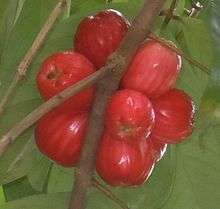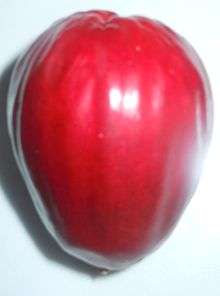Syzygium malaccense
| Malay (rose) apple | |
|---|---|
 | |
Rare (NCA) | |
| Scientific classification | |
| Kingdom: | Plantae |
| Clade: | Angiosperms |
| Clade: | Eudicots |
| Clade: | Rosids |
| Order: | Myrtales |
| Family: | Myrtaceae |
| Genus: | Syzygium |
| Species: | S. malaccense |
| Binomial name | |
| Syzygium malaccense (L.) Merr. & L.M.Perry, 1938 | |
| Synonyms[1] | |
| |
Syzygium malaccense is a species of flowering tree native to Malesia and Australia.[1][2] It has been introduced throughout the tropics, including many Caribbean countries and territories such as Jamaica where it is known simply as "Jamaican apple" or the more common Otaheite apple.
Syzygium malaccense has a number of English common names. It is known as a Malay rose apple, or simply Malay apple, mountain apple, rose apple, Otaheite apple, pink satin-ash and pommerac (derived from pomme Malac, meaning "Malayan apple" in French).[1] Despite the fact that it is sometimes called the otaheite cashew, it is not related to cashew. While cashew nuts (but not cashew fruits) may trigger allergic reactions,[3][4] rose apple fruit has not been observed to do so.[5]
The combination of tree, flowers and fruit has been praised as the most beautiful of the genus Syzygium.[6] The fruit is oblong-shaped and dark red in color, although some varieties have white or pink skins. The flesh is white and surrounds a large seed. Its taste is bland but refreshing. Jam is prepared by stewing the flesh with brown sugar and ginger.

Malay apple is a strictly tropical tree and will be damaged by freezing temperatures.[7] It thrives in humid climates with an annual rainfall of 152 cm (60 in) or more. It can grow at a variety of altitudes, from sea level up to 2,740 m (8,990 ft). The tree can grow to 12–18 m (39–59 ft) in height. It flowers in early summer, bearing fruit three months afterward. In Costa Rica, it flowers earlier, with ripe fruit in April. Coffee growers use the species to divert birds.
In Hawaii, Syzygium malaccense is called mountain apple. When the Polynesians reached the Hawaiian Islands, they brought plants and animals that were important to them. The mountain apple was one of these "canoe plants," arriving 1000–1700 years ago.[8]
 Fruits
Fruits Buds
Buds- Fruits
 A ripened Syzygium malaccense whole.
A ripened Syzygium malaccense whole. A ripened Syzygium malaccense cut into half showing the seed.
A ripened Syzygium malaccense cut into half showing the seed.
References
- 1 2 3 "Syzygium malaccense". Germplasm Resources Information Network (GRIN). Agricultural Research Service (ARS), United States Department of Agriculture (USDA). Retrieved 2009-11-20.
- ↑ Hyland, B. P. M.; Whiffin, T.; Zich, F. A.; et al. (Dec 2010). "Factsheet – Syzygium malaccense". Australian Tropical Rainforest Plants. Edition 6.1, online version [RFK 6.1]. Cairns, Australia: Commonwealth Scientific and Industrial Research Organisation (CSIRO), through its Division of Plant Industry; the Centre for Australian National Biodiversity Research; the Australian Tropical Herbarium, James Cook University. Retrieved 27 Nov 2014.
- ↑ Rance. "Cashew allergy: observations of 42 children without associated peanut allergy".
- ↑ "Substance Info: Cashew Nut".
- ↑ "Substance Info: Rose-apple".
- ↑ Morton, Julia (1987). Fruits of Warm Climates. Florida Flair Books. p. 505. ISBN 978-0-9610184-1-2.
- ↑ "Malay Apple". Plant Characteristics. Pine Island Nursery.
- ↑ Whistler, W. Arthur (2009). Plants of the canoe people: an ethnobotanical voyage through Polynesia. National Tropical Botanical Garden. p. 241. ISBN 978-0-915809-00-4.
- "Malay Apple Syzygium malaccense a.k.a. Mountain Apple". Retrieved 2006-08-18.
| Wikimedia Commons has media related to Syzygium malaccense. |